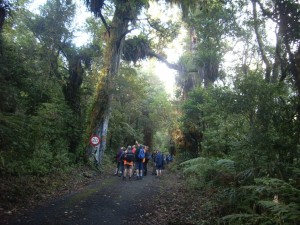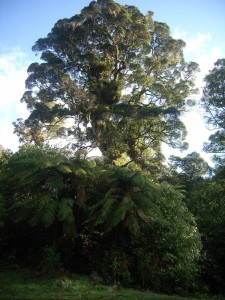 Do you know a place within 30 minutes from a city where you can walk amongst predominantly pristine podocarp forest? Yes – from Wellington! Just go past the Petone waterfront and over the hill into the Wainuiomata Water Collection area!
Do you know a place within 30 minutes from a city where you can walk amongst predominantly pristine podocarp forest? Yes – from Wellington! Just go past the Petone waterfront and over the hill into the Wainuiomata Water Collection area!
The Wainuiomata Water Collection area has stayed almost completely intact, except for a little logging in the main valley, since it was designated as a catchment area around 1878 when an earth dam was built on the Wainuiomata River and a pipeline was laid to Wellington. Developments since that time include the construction of the Morton Dam in 1912, water collection weirs and a pipeline tunnel from Orongorongo Valley in 1926, and a simple water treatment plant in 1964. However, by the late 1980s the system had reached the end of its working life and the Morton Dam was decommissioned and the lake was drained in 1989.
 In 1993 a new treatment plant was constructed which took water from both the Wainuiomata and Orongorongo Rivers. That treatment plant still operates today and produces up to 60 million litres of high quality water daily, supplying a fifth of the water consumed by the greater Wellington metropolitan area.
In 1993 a new treatment plant was constructed which took water from both the Wainuiomata and Orongorongo Rivers. That treatment plant still operates today and produces up to 60 million litres of high quality water daily, supplying a fifth of the water consumed by the greater Wellington metropolitan area.
Water was originally gravity fed to Wellington, but is now assisted by pumping (it takes c10-12 hours for water to get from Wainuiomata to Karori). Today there are 3 other main water collection areas in the Wellington area: Gear Island (Lower Hutt, near the Petone bridge), Waterloo (Lower Hutt), and at Te Marua (Upper Hutt). If required, water could be pumped from one collection area, if for example there was a disruption to water flow, from say an earthquake. It is interesting to note that all these treatment plants are essentially on the fault line!
You can’t just arrive at the Wainuiomata Catchment and walk on your own, as this is a protected area due to its use primarily for catchment reasons. You can however book as an individual or group (we went as a WTMC group of 7, organized by Helen Law). Tour dates are mainly advertised on the Greater Wellington Regional Council website and are led by an experienced tour leader.
On our 22nd May trip the leader was Grant Timlin who was very informative not only about the water collection history of the area, but also on the botanical side of things. As well as Grant there were 5 volunteers, and with them we all walked together as one whole group of around 24 visitors. We started the visit with a hot drink and biscuits while watching a 12 minute video on the 4 main catchment areas around Wellington, then began our walk which lasted from around 9:30am to 2:30pm, including a lunch stop. We went on an 11km tour: Up the road in the direction of George Creek to the tunnel entrance and back, then up the valley past Sinclair Creek as far as Hill Creek. After lunch we returned the same way with a loop back around to the entrance.
There is scope for more extensive walking within the catchment boundaries. On a very hot sunny day in early March 2007 I was part of a WTMC group that did the 24 km loop walk up into the Orongorongo Catchment, which included a fantastic view across to Mt Matthews. We then continued on a track which went past the small gauge rail tunnel and eventually descended into George Creek. As part of that tour one can see more relics of the dam and catchment history. I would recommend that longer trip for keener people who want a more invigorating day walk that really allows one to more fully go through and amongst the range of forest types, in parts on a real track, as opposed to a road!
You might ask what’s so special about the area? This is a valuable remnant of the sort of mixed podocarp-broadleaf-rata lowland forest that was once widespread over much of New Zealand. More locally it gives one an experience of what the Hutt Valley and hills up and over Korokoro, Maungaraki, Belmont etc would have once been like. Amongst the podocarp species there are some big rimu and kahikatea which would be anywhere from 300-500 hundred years old, and within the area there are even older trees! Many of the big podocarps have Astelia (a flax) and other epiphytic plants species growing high up on the branches, which I feel adds to the experience of being in an ancient forest. Indeed, the late Geoff Park, a noted New Zealand botanist and eco-historian in his book Nga Uruora – The Groves of Life (Victoria University Press, 1995) writes in his first chapter that such a forest with these giant podocarps would have been in existence as far back as the age of the dinosaurs – as long as 160 million years ago. He adds that when some of our bird species had been evolving for about 60 million years that the mighty kahikatea had already been around for approximately 100 million years. The thought of this makes me feel very insignificant and humble!! There are also some beech stands in the George Creek area (I think predominantly red beech), and as well there are some enormous mature northern rata.
Regarding wildlife, on our walk we saw fantail, bellbird, tui, wood pigeon, tomtit, rifleman, and even spotted a pig on the bush edge near to a road junction! There are kiwi (I think a North Island species) which was introduced into this area about 4 years ago, and some are now breeding! In this catchment area, as with most of New Zealand there were once more undesirable introduced creatures in abundance such as pig, deer, possums, stoats, rats, feral cats etc, which all have historically reduced native bird, fish and frog species throughout New Zealand, and sadly in some places to extinction. However, with an extensive and continuing pest eradication programme in the Wainuiomata Catchment unwanted pests are now in low numbers, enabling the forest to retain its primordial, prehistoric quality. Because the catchment area ideally wants a pristine environment, including intact forest for premium water quality, let’s hope that the area continues to remain safe and protected so that this rare forest environment stays available for discovery, education and wonderment, not to mention repeated exploration and enjoyment! Wainuiomata Catchment – if you haven’t been there yet, explore it one day soon!
